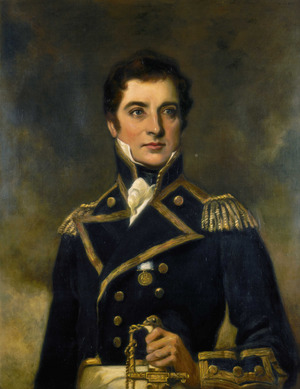William Gordon Rutherfurd facts for kids
Quick facts for kids
William Gordon Rutherford
|
|
|---|---|

Captain William Gordon Rutherford (also Rutherfurd)
|
|
| Born | 1764 Wilmington, North Carolina, U.S. |
| Died | 1818 Greenwich Hospital |
| Buried | |
| Allegiance | |
| Service/ |
|
| Years of service | 1778–1818 |
| Rank | Captain |
| Unit | HMS Boyne HM Sloop Nautilus HMS Adventure HMS Dictator HMS Brunswick HMS Decade HMS Swiftsure |
| Other work | Captain of Royal Naval Hospital, Greenwich |
Captain William Gordon Rutherfurd was a brave officer in the Royal Navy. He served during important times like the French Revolutionary War and the Napoleonic Wars. Most of his career was spent in the West Indies, which are islands in the Caribbean Sea. He is famous for leading the warship HMS Swiftsure at the big Battle of Trafalgar.
Contents
William Rutherfurd was born in Wilmington, North Carolina, in the United States, in 1764. His family later moved to Scotland, where he studied at the University of St Andrews. In 1788, William began his journey at sea aboard HMS Suffolk.
He was a very skilled sailor. When the French revolutionary wars started, he joined a large warship called HMS Boyne. This ship was the main ship for Sir John Jervis in the West Indies. In 1793, William became an acting lieutenant, a junior officer. His rank was made official in January 1794.
Fighting in the West Indies
Rutherfurd was very active during the 1794 West Indies campaign. He showed great courage as a junior officer. He led a group of sailors on land to attack forts on Martinique. He also took part in battles in St Lucia and Guadeloupe.
Because of his excellent actions, he was promoted. On July 4, he became the commander of a small warship, the 16-gun sloop Nautilus.
Becoming a Post Captain
William Rutherfurd stayed in the Caribbean. On November 15, 1796, he was promoted again to Post captain. This was a very important rank. As a captain, he commanded several ships. These included the frigate HMS Adventure and the larger warships HMS Dictator and HMS Brunswick. He also commanded the HMS Decade.
Captain Rutherfurd was key in many small battles against enemy ships. He helped capture Curaçao in 1800, which earned him more praise. In 1804, he returned to Europe with HMS Decade. He joined the Channel Fleet to block French ships near Cherbourg.
The next year, he was given command of a new 74-gun ship called Swiftsure. He helped block the French coast. In the summer of 1805, he was sent to join Admiral Nelson's fleet. This fleet was near Cadiz, preparing for a major battle.
The Battle of Trafalgar
On October 21, 1805, Captain Rutherfurd and his ship Swiftsure were at the famous Battle of Trafalgar. His ship was quite new but had been at sea for a while. This meant it had some damage and could not go very fast.
Reaching the Battle
Swiftsure was far behind Admiral Collingwood's group of ships. It took several hours for Swiftsure to reach the main fight. But when it did, it made a big difference. It fought against the Spanish ship Argonauta and the French ship Achille.
The British ship HMS Belleisle was badly damaged. It had lost its masts and was being attacked by three enemy ships. Suddenly, Swiftsure appeared through the smoke. Its crew cheered, and its guns fired powerful shots. They mainly targeted the French ship Achille.
Saving Lives and Aftermath
The Achille lost its masts and caught fire. Flames quickly spread through the wooden ship. Thousands of French sailors jumped into the sea in a panic. Captain Rutherfurd ordered his ship's small boats to rescue as many survivors as possible. They pulled hundreds of sailors onto Swiftsure. Sadly, some of his own men were lost when the Achilles gunpowder storage suddenly exploded. This explosion sank one of Swiftsures boats.
Swiftsure then tried to fight two more enemy ships, the Aigle and the Neptune. However, the Aigle moved away when its captain saw another British ship, HMS Polyphemus, arriving.
After the battle, Swiftsure was not badly damaged. It tried to tow the sinking French ship Redoutable. But they had to cut the rope when the French ship suddenly sank. Five of Swiftsure's men were among the hundreds who drowned.
Rutherfurd returned to Gibraltar and then to Britain. He was rewarded for his bravery at Trafalgar. However, he spent a lot of time without a ship to command. He was not promoted to Admiral, unlike some other officers.
Later Life and Legacy
In 1814, due to poor health, Captain Rutherfurd was given command of Greenwich Hospital. This was a place for retired sailors. A year later, he was honored with the title of Companion of the Bath.
He passed away in 1818 after a long illness. He was buried in the Church of St. Margaret, Westminster, in London. You can still see his grave marker there today.
Namesake Ship
The Royal Navy honored Captain Rutherfurd by naming a ship after him. This ship was the frigate HMS Rutherford (K558). It was used from 1943 to 1945 and fought in World War II.

